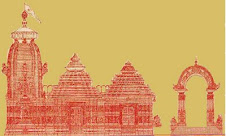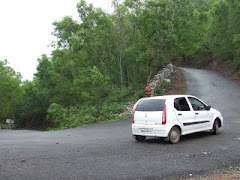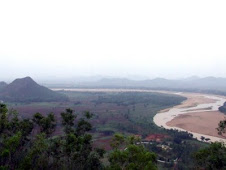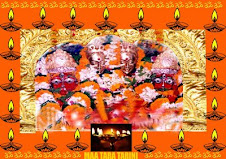R.P.Tripathy
Media & Publicity in charge,
Tara Tarini Development Board (TTDB)
New Delhi
Taratarini Hill Shrine (http:/taratarini.nic.in) near the silk city Berhampur in Orissa is one of the oldest pilgrimage sites of mother goddess and amongst the four major ancient Shakti centers in India. The Mythological Texts recognize four major Shakti peethas (centers), like Bimala, Taratarini, Kamakshya and Dakhina Kalika among the 52 sacred Shakti Peethas, which originated from the limbs of the Corpse of Mata Sati in the Satya Yuga.
Rooted in the hoary past, mentioned in the Puranas, the Tantras and as the main seat of Tantric cult for thousands of years and center of Shakti worship since time immemorial, this Hill Shrine is believed to be the Sthana Peetha (Breast Shrine of Mata Sati) and an important prehistoric religious center which bears an uninterrupted history of not less than 6000 years.
According to mythological texts and folk lore this Shrine has seen all the greatest icons of the human civilization like Lord Ram, Lord Krishna, Lord Parasuram, the Pandavas and great saints like Jagadguru Sankaracharya, Shri Chaitanya and Balayogi Neelakanthi. It has also been the confluence ground of plethora of ancient religions like the Vedic religion, the Brahminical religion, the Hinduism, the Buddhism, the Tantricism etc. Unquestionably, these facts from the Mythology demonstrate the historicity and importance of the Hill Shrine it occupied in the past. Further, the presence of the mythological pious river Rushikulya or Rushikalyani (Known as the elder sister of the Ganges in the Vedas) on the foot hill of the Shrine has further enhanced the significance of the Tara Tarini Dham also known as Kalyani Dham.
According to the Mythological Puranas the origin of Maa Taratarini is directly attributed to Daksha Prajapati’s Jagna in Satya Yuga. The famous Shakta Peethas of Bimala, Tara-Tarini, Dakshina Kalika, and Kamakshi originated from the limbs of the divine Corpse of Devi Sati. Mythological sacred texts like the Shiva Purana, the Kalika Purana, the Devi Bhagabat (a contemporary text of the Mahabharata written by Shri Vyasa Dev around 6000 years ago) attest this fact.
It is known from the Mahabharata that before the commencement of the Mahabharata war Lord Srikrishna had advised Arjuna to offer prayer for victory at Shridevi kupa or Bhadrakali. Bhadrakali originated from the limbs of Sati like the other four major Shakti Peethas, which existed during the time of the Mahabharata or around 6000 years ago. This is the oldest data/information we get till date, regarding the existence of the Shrine of TaraTarini.
According to available historical sources the fall of Kalingan Empire and its capital Sampa (Samapa) in the Kalinga war around 2300 years ago by Mauryan Emperor Ashoka, strengthened the grip of Buddhists in this part of India. The then Sampa was hardly 4 kms away from Taratarini Hill Shrine. So, some scholars believe that Taratarini might be the principal deity (Ista-Devi) of the mighty Kalinga Empire.
According to the texts of Mahayana Buddhists, in the initial days, the Buddhists didn’t believe in the worship of Goddesses or in Pratimapuja (Idol Worship). But, the ecclesiastical texts of Mahayana’s reveal that from 1st century AD after the fall of Kalinga, for the first time the Mahayana Buddhists accepted the worship of Mother Goddess ‘Tara’. So there is seldom any doubt that the Buddhists have learned the ‘Tara’ Puja concept from this Shrine. The Bouddha Tantrik texts, texts of Vajrajani sect and Hindu Tantrik texts also attest these facts. Scholars believe that in the primary days the Buddhists worshiped Taratarini, the principal seat of Tantrik sect in Hinduism at that time, as Bouddha Tara, and later on included ‘Tara’ as the Tantrik deity or spouse of bodhisattva Avalokiteshvara in their belief system. Gradually this ‘Tara’ worship spread to different parts of the world.
Besides the worship of Tara by the Buddhist Tantrikas, the maritime history of Kalinga also suggest the worship of ‘Tara’ by the Sadhavas, merchants and sea-men before launching their sea voyage from the great sea ports like Dantapura (Gopalpur), Pallur near Chilika Lake, kalingapatna and river Rushikulya . It is important to mention, that all these major Seaports of the ancient world were present very near to the Taratarini Hill Shrine.
According to folklore and folk stories, it is around 8th Century AD when Jagadguru Sankaracharya toured the whole country, that he discovered this Shrine. But, it did not exist in its present form. After long try he came to know that this ancient Shakti centre was under the control of Buddhist tantrikas. Then he released this Peetha from the control of Bouddha tantrikas and handed it over to Hindus.
It is known from the available sources that till 17th century this place was out of the sight of the common man. But, according to a folk story once Maa Taratarini appeared as two sisters in the house of Shri Basu Praharaj. He was a learned Brahmin of Kharida Vira Jagannathpur village in Ganjam District and one of the great devotees of the Mother Goddess but child less. After staying for some years one day both the sisters disappeared suddenly from the house of Basu Praharaj and according to the account of the villagers both the sisters traveled up to the Tarini Parvat/ Ratnagiri and disappeared there. Basu Praharaj searched these two sisters but did not find their tracings. His heart broke down with grief and pain. On that night he saw a dream where the Goddesses Tara and Tarini informed Basu Praharaj that actually they were not his daughters; but they are the Goddesses Tara and Tarini. The Goddesses ordered Basu to come out of the grief and said that the time has arrived and with full devotion renovate the temple on the Hill Top of Tarini Parvat and establish the deities according to the tradition.
After that divine direction Basu discovered the tracings of ancient most presence of Goddesses Tara-Tarini on the sacred Hill Top and immediately took steps to reconstruct the temple and the Shrine. Since that time for its magnetism and sanctity this Shakti Peetha became a centre of faith and reverence for countless numbers of people, out in search of peace, tranquility, guidance and spiritual energy and its fame spread like wild fire to become one of the popular religious destinations for millions of devotees.
Rooted in the hoary past, mentioned in the Puranas, the Tantras and as the main seat of Tantric cult for thousands of years and center of Shakti worship since time immemorial, this Hill Shrine is believed to be the Sthana Peetha (Breast Shrine of Mata Sati) and an important prehistoric religious center which bears an uninterrupted history of not less than 6000 years.
According to mythological texts and folk lore this Shrine has seen all the greatest icons of the human civilization like Lord Ram, Lord Krishna, Lord Parasuram, the Pandavas and great saints like Jagadguru Sankaracharya, Shri Chaitanya and Balayogi Neelakanthi. It has also been the confluence ground of plethora of ancient religions like the Vedic religion, the Brahminical religion, the Hinduism, the Buddhism, the Tantricism etc. Unquestionably, these facts from the Mythology demonstrate the historicity and importance of the Hill Shrine it occupied in the past. Further, the presence of the mythological pious river Rushikulya or Rushikalyani (Known as the elder sister of the Ganges in the Vedas) on the foot hill of the Shrine has further enhanced the significance of the Tara Tarini Dham also known as Kalyani Dham.
According to the Mythological Puranas the origin of Maa Taratarini is directly attributed to Daksha Prajapati’s Jagna in Satya Yuga. The famous Shakta Peethas of Bimala, Tara-Tarini, Dakshina Kalika, and Kamakshi originated from the limbs of the divine Corpse of Devi Sati. Mythological sacred texts like the Shiva Purana, the Kalika Purana, the Devi Bhagabat (a contemporary text of the Mahabharata written by Shri Vyasa Dev around 6000 years ago) attest this fact.
It is known from the Mahabharata that before the commencement of the Mahabharata war Lord Srikrishna had advised Arjuna to offer prayer for victory at Shridevi kupa or Bhadrakali. Bhadrakali originated from the limbs of Sati like the other four major Shakti Peethas, which existed during the time of the Mahabharata or around 6000 years ago. This is the oldest data/information we get till date, regarding the existence of the Shrine of TaraTarini.
According to available historical sources the fall of Kalingan Empire and its capital Sampa (Samapa) in the Kalinga war around 2300 years ago by Mauryan Emperor Ashoka, strengthened the grip of Buddhists in this part of India. The then Sampa was hardly 4 kms away from Taratarini Hill Shrine. So, some scholars believe that Taratarini might be the principal deity (Ista-Devi) of the mighty Kalinga Empire.
According to the texts of Mahayana Buddhists, in the initial days, the Buddhists didn’t believe in the worship of Goddesses or in Pratimapuja (Idol Worship). But, the ecclesiastical texts of Mahayana’s reveal that from 1st century AD after the fall of Kalinga, for the first time the Mahayana Buddhists accepted the worship of Mother Goddess ‘Tara’. So there is seldom any doubt that the Buddhists have learned the ‘Tara’ Puja concept from this Shrine. The Bouddha Tantrik texts, texts of Vajrajani sect and Hindu Tantrik texts also attest these facts. Scholars believe that in the primary days the Buddhists worshiped Taratarini, the principal seat of Tantrik sect in Hinduism at that time, as Bouddha Tara, and later on included ‘Tara’ as the Tantrik deity or spouse of bodhisattva Avalokiteshvara in their belief system. Gradually this ‘Tara’ worship spread to different parts of the world.
Besides the worship of Tara by the Buddhist Tantrikas, the maritime history of Kalinga also suggest the worship of ‘Tara’ by the Sadhavas, merchants and sea-men before launching their sea voyage from the great sea ports like Dantapura (Gopalpur), Pallur near Chilika Lake, kalingapatna and river Rushikulya . It is important to mention, that all these major Seaports of the ancient world were present very near to the Taratarini Hill Shrine.
According to folklore and folk stories, it is around 8th Century AD when Jagadguru Sankaracharya toured the whole country, that he discovered this Shrine. But, it did not exist in its present form. After long try he came to know that this ancient Shakti centre was under the control of Buddhist tantrikas. Then he released this Peetha from the control of Bouddha tantrikas and handed it over to Hindus.
It is known from the available sources that till 17th century this place was out of the sight of the common man. But, according to a folk story once Maa Taratarini appeared as two sisters in the house of Shri Basu Praharaj. He was a learned Brahmin of Kharida Vira Jagannathpur village in Ganjam District and one of the great devotees of the Mother Goddess but child less. After staying for some years one day both the sisters disappeared suddenly from the house of Basu Praharaj and according to the account of the villagers both the sisters traveled up to the Tarini Parvat/ Ratnagiri and disappeared there. Basu Praharaj searched these two sisters but did not find their tracings. His heart broke down with grief and pain. On that night he saw a dream where the Goddesses Tara and Tarini informed Basu Praharaj that actually they were not his daughters; but they are the Goddesses Tara and Tarini. The Goddesses ordered Basu to come out of the grief and said that the time has arrived and with full devotion renovate the temple on the Hill Top of Tarini Parvat and establish the deities according to the tradition.
After that divine direction Basu discovered the tracings of ancient most presence of Goddesses Tara-Tarini on the sacred Hill Top and immediately took steps to reconstruct the temple and the Shrine. Since that time for its magnetism and sanctity this Shakti Peetha became a centre of faith and reverence for countless numbers of people, out in search of peace, tranquility, guidance and spiritual energy and its fame spread like wild fire to become one of the popular religious destinations for millions of devotees.













.jpg)

.jpg)





































No comments:
Post a Comment